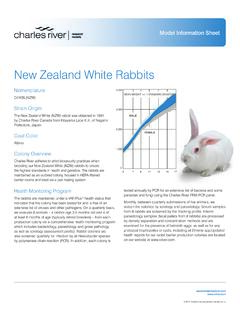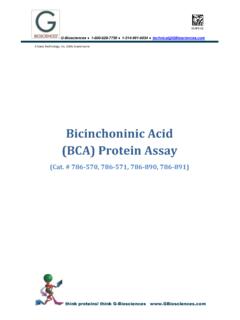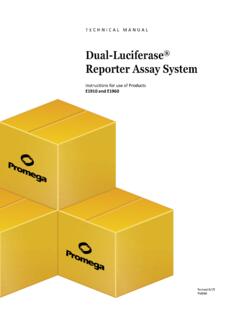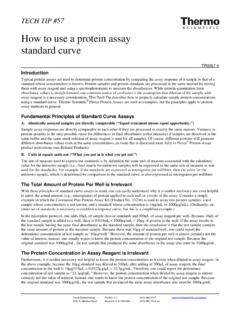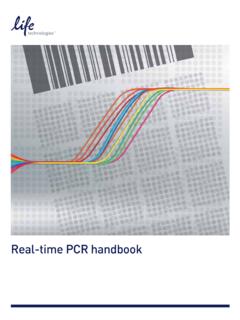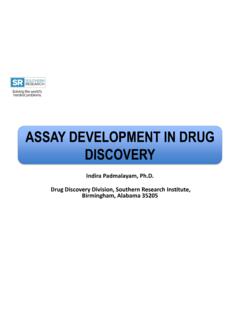Transcription of the endosafe nexgen-pts
1 The endosafe nexgen-pts assay GUIDE WITH USER MANAGEMENT08 Prior to testing, be sure you have access to the Certificate of Analysis (COA), which can be found within your endosafe -PTS cartridge package or on the endosafe customer portal ( ). This information includes the cartridge lot number and calibration series of prompts will appear for you to enter the information necessary to run the assay , including Cartridge Lot #, Cartridge CAL Code, Sample ID, Sample Lot, Dilution and Endotoxin Limit. Enter values for each field, clicking the Next button until all fields are the necessary values are entered, confirm all inputted values on the next screen. The reader will display a prompt to Add Sample to a calibrated pipettor, dispense exactly 25 L of sample into all 4 wells of the cartridge. Be sure to hold the pipette so that the tip is at an angle, and not completely at the bottom of the sample reservoir.* Click the Done Start Test icon on the home screen to initiate testing.
2 12 Test results will appear on screen when the assay is complete. You can send this data to a network printer, Zebra printer, download to Charles River Cortex , or save to a the pipette straight up and down at the bottom of the sample well can force some sample into the channel early and disrupt the reagent mixing stations. Avoid any technique that is prone to splash out or out will render the volume inaccurate, which can lead to invalid test results. Bubbles can cause false onset times due to the disturbance of light transmittance and can interfere with reconstitution of reagents within the on the reader by pressing the button at the rear right-hand side of the back panel. As the instrument boots up, the Charles River logo will display on the touch screen. 02At the Enter Operator ID prompt, enter your username and click the Enter Operator Password prompt, enter your password and click Next. 04As the reader warms in preparation for use, the Initializing message appears.
3 When the unit has reached C, the screen will display the Insert Cartridge message. 05 Allow cartridges to reach room temperature in pouch before using. Remove cartridge from pouch and avoid touching the sample the cartridge firmly into the slot at the front of the reader with sample wells facing up. 07 The reader will then verify cartridge integrity; used or damaged cartridges will signal an alert.*IMPROPER TECHNIQUEB ubblesSplash outTechnical Assistance: US: EU: : This refers to the lowest concentration in the standard curve; in this example lambda equals EU/mL. Charles River offers cartridge sensitivities ranging from recovery: The spike is a known amount of endotoxin that acts as the positive control. This control serves as a check for interference (inhibition and enhancement). Inhibition and enhancement are conditions that adversely alter the recovery of endotoxin in a test sample. Inhibition presents itself as less than 50% spike recovery, where enhancement is typically greater than 200%.
4 For a valid assay , the spike recovery value must be between 50% and 200%, thus indicating no significant interference from the test Results from the Zebra Printer (reference the Zebra Printer Quick-Start Guide for setup directions)1. Connect cable-USB connection to printer and micro-USB to nexgen-pts At the end of a test, the user can print results from the Report menu under Administrative Accessories for Running a Test on the nexgen-pts *PTS Cartridges: Cartridges come in a variety of sensitivities and packaging configurations, as well as FDA-licensed and unlicensed. Licensed cartridges should be used for official release of product, and unlicensed cartridges can be used for research and Reagent Water (LRW): LRW is water that is free of detectable endotoxin and non-interfering to the assay . Charles River Laboratories offers LRW in a variety of sizes. Note: Many samples will require dilution in LRW to avoid interference with bacteria endotoxin Tubes: Tubes for sample dilution should be free of detectable endotoxin.
5 Charles River offers a variety of sizes of borosilicate tubes for dilution. Note: Certain types of plastics can cause interference with bacteria endotoxin assay . Contact Technical Services for more : Charles River Laboratories offers several buffers for sample adjustment to account for pH, divalent cation reduction, and glucan-related interference. Contact Technical Services for advice on buffer : Charles River Laboratories offers glass depyrogenated, serological pipettes in a variety of sizes. Pipettes used for sample dilution should be free of detectable endotoxin and non-interfering to the assay , as well as free of cotton L Pipettor: A mini, disposable pipettor is supplied with the nexgen-pts system. Note: It is recommended to obtain a fixed 25 L pipettor that can be calibrated to ensure optimal Tips: Charles River Laboratories offers Eppendorf pipette tips that are individually wrapped. Note: It is recommended that the user avoids pipette tips that contain a cotton plug/filter.
6 * Not Included. See catalog for pricing and product sensitivity range Lambda = lowest value ( EU/mL)Reaction time of 4 channels 1 & 3 are sample channels, 2 & 4 are spiked channelsDilution factor/Concentration 1:1=neat, 1:10, 1:100, mg/mL, mg/mL, % of channels 1 & 3 Represents variation in reaction times of the two sample replicates Must be < 25% for a valid test resultCV % of channels 2 & 4 Represents variation in reaction times of the two spiked replicates Must be < 25% for a valid test resultSpike recovery Represents % of spike that was recovered in channels 2 & 4 Must be between 50% and 200% for a valid test resultTest suitability Evaluates sample CV, spike CV, and spike recovery for validity and assigns Pass/Fail grade. Pass indicates a valid test and the sample value can be EU value for sample (factoring in dilution) If sample is non-reactive, EU value = lambda multiplied by dilution factor or lambda divided by concentration.








